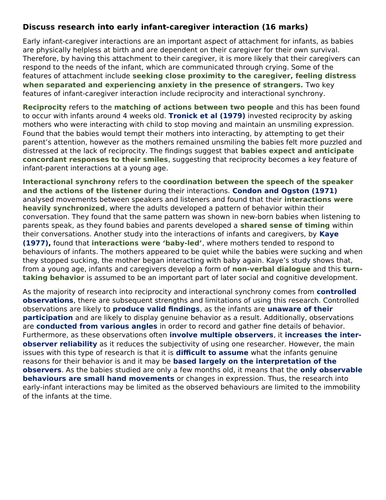

Cultural Variations In Attachment
March 5, 2021 - paper 1 introductory topics in psychology | attachment.
- Back to Paper 1 - Attachment
Cross Cultural Variations In Attachment, (Description, AO1):
Cross-Cultural Variations in Attachment Definition: The ways members of a society/culture vary in terms of their social practices (child-rearing). These variations, in turn, can effect infant development and behaviour. This can lead to cultural differences in attachment type.
- In Japan it is rare to leave an infant alone and their mothers rarely leave them in the care of others.
- In Germany, parents value independence. Some of the behaviour in the strange situation which is supposed to indicate secure attachment is seen by German parents as ‘clingy’.
Van Ijzendoorn looked at a large number of studies using the Strange Situation across cultures in order to assess whether or not there were cross-cultural variations of attachment.
Aim: To investigate cross-cultural differences in attachment type through meta-analysis of research, comparing findings of the Strange Situation research conducted in other cultures
Research Methods Checkpoint!! What is a meta-analysis?
A meta-analysis is when no new research is conducted. The researchers carrying out the meta-analysis use findings and results from previously conducted studies in order to draw conclusions about (in this case) cross cultural variations in attachment.
Procedure: Compared the findings of 32 studies across 8 different countries that used the strange situation to measure attachment type. Specifically comparing Western (e.g. Britain and Germany) and non-western cultures (e.g. Japan, China). As part of your description (AO1) for this study, you would simply outline the key observations of Ainsworth’s Strange Situation study as Van Izerndoorn carried out his meta-analysis on pieces of research that had used Ainsworth’s methodology. Mary Ainsworth study used an observation, to find out more about this research method including its key features and the strengths and weaknesses of this procedure, click here.
- There was wide variation between the proportions of attachment types of different studies.
- In all countries Secure attachment was the most common attachment type. However, the proportion varied from 75% in Britain to 50% in China.
- Insecure-Resistant was overall the least common type although, the proportions ranged from 3% in Britain to 30% in Israel.
- Insecure-Avoidant attachments were observed most commonly in Germany and least commonly in Japan.
Conclusions: Secure attachment seems to be the norm in a wide range of cultures, supporting Bowlby’s idea that attachment is innate and universal and that this type of attachment is the universal norm. However, the research also shows that cultural practices in child rearing have an influence on attachment type.
For more information on the original Strange Situation study as conducted by Mary Ainsworth, click here.
Evaluation Of Van Ijzendoorn’s Metaa-Analysis,(AO3):
(1) POINT: A strength of combining the results of attachment studies carried out in different countries is that researchers can end with a very large sample. EXAMPLE/EVIDENCE: For example, in the Van Ijzendoorn meta-analysis there was a total of nearly 2000 babies and their primary attachment figures. EVALUATION: This is a strength because large samples increase internal validity by reducing the impact of anomalous results caused by bad methodology.
Weaknesses:
(1) POINT: However, comparing cultures using the same ‘Strange Situation’ attachment behaviour interpretations may be ‘ethnocentric’ . EXAMPLE/EVIDENCE : For example, the Strange Situation was designed by Ainsworth (an American researcher) based on a British theory (Bowlby). In the strange situation, a lack of separation anxiety and a lack of pleasure on reunion indicate an insecure attachment. In Germany, this behaviour may be seen as independence rather than avoidance and hence not a sign of insecurity within that cultural context. EVALUATION : This is a problem because it can be questioned whether Anglo-American theories and assessments can be applied to other cultures (imposed etic). Therefore, cross cultural comparisons using the ‘strange situation’ may lack validity.
(2) POINT: Furthermore, Grossman used the Strange Situation technique which can be criticised as lacking ecological validity. EVIDENCE/EXAMPLE: For example , the ‘playroom’ environment in which the infant was interacting in was both strange and unfamiliar to the infant’s everyday environment. This means that, because the research was conducted in a laboratory, the environment is artificial. EVALUATION: This is a weakness because it is possible that the experiment was not measuring the infant’s natural behaviour and as a result, the findings cannot be generalise past the study.
- Psychopathology
- Social Psychology
- Approaches To Human Behaviour
- Biopsychology
- Research Methods
- Issues & Debates
- Teacher Hub
- Terms and Conditions
- Privacy Policy
- Cookie Policy
- [email protected]
- www.psychologyhub.co.uk
We're not around right now. But you can send us an email and we'll get back to you, asap.
Start typing and press Enter to search
Cookie Policy - Terms and Conditions - Privacy Policy
- International
- Schools directory
- Resources Jobs Schools directory News Search

AQA A-Level Psychology: Attachment A* Exam Practice Exemplar Essays
Subject: Psychology
Age range: 16+
Resource type: Assessment and revision
Last updated
24 April 2023
- Share through email
- Share through twitter
- Share through linkedin
- Share through facebook
- Share through pinterest

AQA Psychology A-level: Attachment From specification 7181, 7182 paper 1 (I achieved an A* in Psychology A-level in 2018, across all three papers. I prioritised revision on evaluation, necessary for accessing higher grade!) These are my example essay practice questions
Includes: Discuss research into early infant-caregiver interaction (16 marks) Outline and evaluate research by Schaffer and Emerson into attachment (16 marks) Outline and evaluate research into the stages of attachment (16 marks) Outline and evaluate research the role of the father (16 marks) Outline and evaluate animal studies into attachment (16 marks) Outline and evaluate learning theory as an explanation for attachment (16 marks) Outline and evaluate Bowlby’s monotropic theory as an explanation for attachment (16 marks) Outline and evaluate Ainsworth’s ‘Strange Situation’ research (16 marks) Outline and evaluate cultural variations of attachment (16 marks) Outline and evaluate Bowlby’s theory of maternal deprivation (16 marks) Discuss research into the effects of institutionalization (16 marks) / Outline and evaluate Rutter’s study of Romanian orphans (16 marks) Discuss research into the influence of early attachment (16 marks)
Tes paid licence How can I reuse this?
Get this resource as part of a bundle and save up to 25%
A bundle is a package of resources grouped together to teach a particular topic, or a series of lessons, in one place.
AQA Psychology A-Level: Attachment Bundle (A* Notes and Exemplar Essays)
**AQA Psychology A-level: Attachment** From specification 7181, 7182 - Introductory topics in Psychology (I achieved an A* in Psychology A-level in 2018, across all three papers. I prioritised revision on evaluation, necessary for accessing higher grade!) **NOTES:** * Caregiver-infant interaction * Attachment vs bond, features of attachment and importance of attachment * Studies of early interaction and findings * Reciprocity, Tronick et al (1979), and interactional synchrony, Condon and Ogston (1971) * Attachment development * Schaffer and Emerson longitudinal study and evaluation * Stages of attachment and evaluation * Attachment figures - Grossman (2002) and fathers as primary caregivers, and evaluation * Animal studies * Lorenz’s geese studies and evaluation - imprinting for survival and critical period * Harlow’s monkey study and evaluation, including experiment variations and findings * Explanations for attachment * Learning theory - classical conditioning and operant conditioning (Skinner) - and evaluation * Bowlby’s monotropic theory and evaluation - instinctive attachment, monotropy, internal working model etc. * Types of attachment * Ainsworth’s Strange Situation (1970) and evaluation of attachment types * Causes of individual differences in attachment * Cultural variations in attachment - Van Ijzendoorn and Kroonenberg (1988) and evaluation * Deprivation * Bowlby’s theory of Maternal Deprivation and 44 thieves study, and evaluation * Romanian orphan study - Rutter et al and evaluation * Effects of institutionalisation, disinhibited attachment and evaluation * Influence of early attachment * Hazen and Shaver (1987) - study for internal working model * Evidence for behaviour influenced by internal working model and evaluation **ESSAY QUESTIONS** * Discuss research into early infant-caregiver interaction (16 marks) * Outline and evaluate research by Schaffer and Emerson into attachment (16 marks) * Outline and evaluate research into the stages of attachment (16 marks) * Outline and evaluate research the role of the father (16 marks) * Outline and evaluate animal studies into attachment (16 marks) * Outline and evaluate learning theory as an explanation for attachment (16 marks) * Outline and evaluate Bowlby’s monotropic theory as an explanation for attachment (16 marks) * Outline and evaluate Ainsworth’s ‘Strange Situation’ research (16 marks) * Outline and evaluate cultural variations of attachment (16 marks) * Outline and evaluate Bowlby’s theory of maternal deprivation (16 marks) * Discuss research into the effects of institutionalization (16 marks) / Outline and evaluate Rutter’s study of Romanian orphans (16 marks) * Discuss research into the influence of early attachment (16 marks)
AQA A-Level Psychology Paper 1 - A* Example Essays
AQA Psychology A-level: Attachment, Memory, Psychopathology and Social Influence From specification 7181, 7182 - Introductory topics in Psychology (I achieved an A* in Psychology A-level in 2018, across all three papers. I prioritised revision on **evaluation**, necessary for accessing higher grade!) -> These are FULL 16 mark example essays I created for revision, which helped me get my A*! Attachment: Discuss research into early infant-caregiver interaction (16 marks) Outline and evaluate research by Schaffer and Emerson into attachment (16 marks) Outline and evaluate research into the stages of attachment (16 marks) Outline and evaluate research the role of the father (16 marks) Outline and evaluate animal studies into attachment (16 marks) Outline and evaluate learning theory as an explanation for attachment (16 marks) Outline and evaluate Bowlby's monotropic theory as an explanation for attachment (16 marks) Outline and evaluate Ainsworth's 'Strange Situation' research (16 marks) Outline and evaluate cultural variations of attachment (16 marks) Outline and evaluate Bowlby's theory of maternal deprivation (16 marks) Discuss research into the effects of institutionalization (16 marks) / Outline and evaluate Rutter's study of Romanian orphans (16 marks) Discuss research into the influence of early attachment (16 marks) Memory: Outline and evaluate the multi-store model of memory (16 marks) Outline and evaluate the working memory model (16 marks) Outline and evaluate the types of long-term memory (16 marks) Outline and evaluate interference theory as an explanation for forgetting (16 marks) Outline and evaluate retrieval failure as an explanation for forgetting (16 marks) Outline and evaluate the effect of misleading information on eye witness testimony (16 marks) Outline and evaluate the effect of anxiety on eye witness testimony (16 marks) Outline and evaluate the use of the cognitive interview in improving the accuracy of eye witness testimony (16 marks) Psychopathology: Outline and evaluate two ways of defining abnormality (16 marks) x2 Outline the characteristics of phobias (6 marks) Outline the characteristics of OCD (6 marks) Outline the characteristics of depression (6 marks) Discuss behavioural explanations for phobias (16 marks) Outline and evaluate the behavioural approach to treating phobias (16 marks) Outline and evaluate one or more biological explanation for obsessive-compulsive disorder (16 marks) x2 Discuss the biological approach for treating OCD (16 marks) Outline and evaluate one or more cognitive explanations for depression (16 marks) x2 Discuss the cognitive approach to treating depression (16 marks) Social Influence: Outline and evaluate explanations for conformity (16 marks) Discuss research by Asch into conformity (16 marks) Discuss research by Zimbardo into conformity (16 marks) Discuss research by Milgram into obedience (16 marks) Outline and evaluate the situational factors affecting obedience (16 marks) Outline and evaluate legitimacy of authority and the agentic state (16 marks) Outline and evaluate Adorno's authoritarian personality (16 marks) Discuss social support as an explanation for the resistance to social influence (8 marks) Outline and evaluate Rotter's LOC as an explanation for resistance to social influence (16 marks) Discuss research into minority influence and its implications on resistance of social influence (16 marks) Outline and evaluate social change and its implications on resistance to social influence (16 marks)
Your rating is required to reflect your happiness.
It's good to leave some feedback.
Something went wrong, please try again later.
This resource hasn't been reviewed yet
To ensure quality for our reviews, only customers who have purchased this resource can review it
Report this resource to let us know if it violates our terms and conditions. Our customer service team will review your report and will be in touch.
Not quite what you were looking for? Search by keyword to find the right resource:
- Attachment Styles
- Start to Heal

For All Styles

- Attachment & Bonding
through Bodynamic

Learn Energy Management

- Emotional Alchemy
Restore Your Inner Balance

- Anxious Attachment
How does it develop in childhood?

- Avoidant Attachment
What are symptoms in adult relationships?

- Disorganized Attachment
What is it like to date a disorganized adult?

- Secure Attachment
The 5 conditions for secure attachment

Cultural Variations in Attachment
The bond between a caregiver and child is universally important, regardless of race, religion, ethnicity, or culture. We are all born with the drive to connect to our caregiver. If this relationship is healthy and strong, often our other relationships will thrive. However, if cracks form in this early relationship, it can trigger a lot of difficulties later in life.
So, attachment bonds are universal in some ways, but are all aspects of attachment across different cultures the same? Evidence suggests not. Yet, attachment bonds may vary in different ways to what we might initially imagine.
To answer all of your questions regarding cultural variations in attachment, this article will cover:
- What attachment is
- A brief history of attachment styles
- The cultural variations in attachment
- Possible reasons for cultural variations in attachment
- The accuracy of the research on the cultural variations in attachment
Do you know your attachment style? Take our attachment quiz and find out now – fast, easy, free.

What Is Attachment?
According to John Bowlby, who could be called the “founding father” of attachment theory , attachment is “a lasting psychological connectedness between human beings.”
But how could attachment be explained in simpler terms? Well, it could easily be explained by describing it as an emotional bond that forms between a child and their caregiver. Attachment becomes established by the way the caregiver responds to the child: If the caregiver is responsive to the child, and responds with warmth and empathy, the child will feel safe and secure in the world . However, if the caregiver doesn’t consistently respond to their child, or they are harsh or punitive, the child may develop negative beliefs about others, themself, and the world, such as:
- “Others aren’t to be trusted.”
- “I’m not good enough to be cared for.”
- “The world isn’t safe.”
In essence, the way our caregiver responds to us in infancy shapes our attachment style , which then impacts our relationships with others in childhood, adolescence, and adulthood. So, what are the attachment styles?
A History of Attachment Styles
In the early 1950s, Canadian psychologist Mary Ainsworth joined Bowlby in his attachment research. Ainsworth focused her efforts on understanding the interindividual differences of attachment. She researched babies and their mothers in Uganda and the US, attempting to predict a pattern between caregiver behaviors and infant attachment types.
However, she quickly began to notice differences in Ugandan and US families. For example, in Baltimore, babies experienced their caregivers leaving and returning more often than those from Uganda, which meant they were less likely to cry when left on their own . Babies from other parts of the US were also less likely to cling to their caregivers when they returned.
Due to these differences, Ainsworth adapted her tests, creating a laboratory experiment called “The Strange Situation,” which involved putting the babies under slight stress to draw out their attachment style. This laboratory experiment involved 8 different scenarios between the mothers and babies:
- Mother and baby are introduced to the room.
- Mother sits and responds to the baby while they play freely for several minutes.
- A stranger enters, chats to the mother, then to the baby.
- Mother leaves the room for three minutes.
- Mother returns and greets her baby.
- Both the stranger and mother leave the baby, so they are on their own for three minutes.
- Stranger returns on their own and greets the baby.
- Mother returns and attempts to comfort her baby.
Ainsworth observed the babies during this procedure to see how they responded to their mother leaving and returning, and how they reacted to a stranger. Through this, she noticed three different behavior patterns, which she called “ attachment styles .” These were:
- Insecure-avoidant (later known as avoidant attachment )
- Insecure-ambivalent (later known as anxious attachment )
In later research, psychologists Mary Main and Judith Solomon noticed a pattern of behavior in children which didn’t fit with the previously established styles, and, thus, identified a fourth attachment style, known as disorganized-insecure .
The Strange Situation experiment has been used across the world as a standard measure of infant’s attachment styles . However, this procedure isn’t suitable for older children, and certainly wouldn’t be fitting for adults (for obvious reasons). Instead, we can use a series of multiple choice questions to identify our attachment styles as adults.
Want to find out what your attachment style is? You can do so using the free Attachment Style Quiz on our website.
Are There Cultural Variations in Attachment?
We’ve already seen the difficulties Ainsworth faced when trying to replicate her findings on attachment patterns across cultures. So, this left many people wondering whether there are cultural variations in attachment. The research suggests that yes, there are cultural variations in attachment, but perhaps not in the way one might initially expect.

Cultural Variations in the Distribution of Attachment Styles
The research suggests that the main cultural variations in attachment are to do with the distribution of the attachment styles . For example, van Ijzendoorn & Kroonenberg replicated the Strange Situation procedure in a meta-analysis of eight different countries. They found a similar pattern to Ainsworth in the US, UK, China, Sweden, Japan, Germany, Holland, and Israel. This pattern was:
- 65% securely attached
- 21% avoidantly attached
- 14% anxiously attached
However, there have been different findings in other countries. For example, in Northern Germany, they found that 52% of infants were avoidantly attached, with only 34% and 13% of infants securely and anxiously attached, retrospectively.
Furthermore, a study conducted in Japan found that 68% of infants were securely attached. While this may sound similar to other findings, just wait until you hear about the distribution of insecure attachment! Japanese children only fell into the anxiously attached insecure category, with none meeting the criteria for avoidant.

Differences in Attachment Within Cultures
We can also see differences in attachment styles within cultures. Going back to van Ijzendoorn & Kroonenberg’s study, they found that differences within cultures were far greater than variations in attachment across cultures– nearly one and a half times greater! Why might this be?
Well, van Ijzendoorn & Kroonenberg suggested there are various subcultures within a single culture. They also believed that the variation within cultures could be due to things like socio-economic factors and stress levels. For example, children born in poverty or with lower socio-economic status, or who were exposed to higher stress levels, were more likely to be insecurely attached.
But van Ijzendoorn & Kroonenberg’s ideas only cover a small portion of the research on cultural variations in attachment. So, what are the other possible reasons for these differences?
Reasons For Cultural Variations in Attachment
When researchers considered the possible reasons for cultural variations in attachment over the years, multiple caregivers and cultural differences in what was considered to be “stranger danger” were two factors that particularly stuck out.
#1 Multiple Caregivers and Cultural Variations in Attachment
One particularly evident difference in caregiving patterns between cultures is the number of caregivers present in a child’s life from infancy. Research suggests that in Western cultures, we often view attachment as a “monotropic bond,” meaning we envisage one mother and one baby. However, in other cultures, a caregiving system of multiple caregivers is more common.
When we think about it, none of us would have survived through evolution if mothers didn’t receive help from other caregivers, such as siblings, grandparents, and other relatives. Not only did our ancestors spread the caregiving requirements across multiple caregivers, but they also distributed the cost of raising a child and the domestic activities like gathering and working in the fields.
This way of living and functioning as a family unit is still present in some cultures, such as the Efé people in the Ituri Rainforest of the Democratic Republic of Congo. Among Efé people, newborn babies are held, carried, and nursed by many women. By six weeks of age, Efé infants spend more time with other people than with their biological mother.
When we consider these caregiving patterns, it’s easy to see why cultural variations in attachment exist. Variations in beliefs about “stranger danger” across cultures also help us understand these differences.

#2 Cultural Variations in “Stranger Danger”
In the Strange Situation procedure, strangers are introduced to allow researchers to see a baby’s response to stress. However, “stranger danger” doesn’t necessarily translate across cultures. For some cultures, stranger danger doesn’t exist, voiding the “stranger” part of the Strange Situation procedure .
For example, the Beng people in West Africa teach their children to welcome strangers with open arms. Beng babies are also likely to be introduced to many different people right from birth, and are often left to interact with unknown people. A similar attitude is instilled in Brazilian Piraha Indian babies.
If we consider the people we are exposed to as babies in Western cultures–typically just close relatives and friends–we can see how the concept of “stranger danger” may look different across cultures, which likely influences the attachment patterns we see.

Is the Research On Cultural Variations in Attachment Accurate?
If you grouped attachment experts together, they’d likely passionately argue about how accurate the research on cultural variations in attachment is. It’s a highly debated topic for a couple of reasons.
Firstly, evidence suggests that the way researchers select, shape, and interpret the behaviors babies show in the Strange Situation procedure are culturally patterned . Some researchers suggest that the Strange Situation is a Westernized way of looking at attachment patterns, which means that attachment bonds may show up as similar across cultures, even if they’re not.
The accuracy of the research on cultural variations in attachment may also come down to the idea of “caregiver sensitivity.” Caregiver sensitivity is the primary caregiver’s ability to respond promptly and appropriately to their infant’s signals, such as when they need feeding, changing, or to sleep. Evidence demonstrates that caregivers who show greater sensitivity are more likely to have healthier attachments to their children. But how does this relate to cultural variations?
Well, research indicates that levels of caregiver sensitivity are relatively stable across cultures. For example, similar levels of caregiver sensitivity are found in Japanese, Israeli, and US families, as well as other non-Western cultures. However, the cultural differences appear to lie in the way caregivers respond to their infants . For example, African mothers have been found to talk less to their infants compared to mothers from Europe, the Far East, and South and North America. Another example would be how Palestinian-Arab mothers tend to show more positive responses to their babies’ distress, whereas Jewish mothers may respond by matching their babies’ emotional state.
So, testing to see mother’s responses to their babies, and the babies’ responses back, may not be enough to measure the caregiver-child bond. Based on current findings, it’s safe to say that more research is needed for us to fully understand the cultural variations in attachment.

Cultural variations in attachment appear to exist. However, the differences seem to be in the distribution of attachment styles, rather than the attachment bonds themselves. And surprisingly, the differences that do exist appear to be more within cultures than between them.
The cultural differences we see in attachment bonds may relate to the number of caregivers we’re exposed to as infants and how the concept of “stranger danger” looks different across cultures. However, the idea of cultural variations in attachment is a highly debated topic, with some experts arguing that the research is biased toward a Westernized view of caregiver-child bonds.
The only thing we know for sure is this: we need more research on the potential differences in attachment across cultures before we can come to any solid conclusions.
Abu Salih, M., Abargil, M., Badarneh, S., Klein Selle, N., Irani, M., & Atzil, S. (2023). Evidence for cultural differences in affect during mother-infant interactions. Scientific reports, 13(1), 4831.
Bowlby, J. (1969). Attachment and loss: Volume 1. Attachment. Basic Books.
Granqvist P. (2021). Attachment, culture, and gene-culture co-evolution: expanding the evolutionary toolbox of attachment theory. Attachment & human development, 23(1), 90–113.
Keller, H. (2013). Attachment and culture. Journal of Cross-cultural psychology, 44(2), 175-194.
Miller, J. G., Harwood, R. L., Irizarry, N. L. (1997). Culture and Attachment: Perceptions of the Child in Context. Guilford Publications.
Rothbaum, F., Weisz, J., Pott, M., Miyake, K., & Morelli, G. (2000). Attachment and culture. Security in the United States and Japan. The American psychologist, 55(10), 1093–1104.
Van IJzendoorn, M. H., & Kroonenberg, P. M. (1988). Cross-cultural patterns of attachment: A meta-analysis of the strange situation. Child Development, 59(1), 147–156
Get mental health tips straight to your inbox
I would like to sign up for the newsletter I agree with terms and conditions and privacy policy
Final dates! Join the tutor2u subject teams in London for a day of exam technique and revision at the cinema. Learn more →
Reference Library
Collections
- See what's new
- All Resources
- Student Resources
- Assessment Resources
- Teaching Resources
- CPD Courses
- Livestreams
Study notes, videos, interactive activities and more!
Psychology news, insights and enrichment
Currated collections of free resources
Browse resources by topic
- All Psychology Resources
Resource Selections
Currated lists of resources
Quizzes & Activities
Attachment: Cultural Variations in Attachment | AQA A-Level Psychology
Last updated 22 Dec 2023
- Share on Facebook
- Share on Twitter
- Share by Email
This topic quiz tests A-Level Psychology students knowledge of research into cultural variations in attachment styles.
Click here to access the quiz: Attachment: Cultural Variations in Attachment | AQA A-Level Psychology
Attachment theory suggests that infants develop a strong emotional bond with their caregivers, which provides a sense of security and emotional support. However, cultural variations in attachment have been observed across different societies. Here are some examples:
- Individualistic cultures , such as those found in Western societies, tend to value independence and autonomy. In these cultures, infants are encouraged to explore their environment and develop a sense of self-reliance. As a result, attachment styles in individualistic cultures tend to be more insecure-avoidant.
- Collectivist cultures, such as those found in East Asian societies, place a greater emphasis on interdependence and familial bonds. Infants in these cultures are encouraged to stay close to their caregivers and develop a strong sense of attachment. As a result, attachment styles in collectivist cultures tend to be more secure.
- Indigenous cultures , such as those found in Africa, place a strong emphasis on community and shared responsibility for childrearing. Attachment styles in these cultures tend to be more communal and secure.
Overall, cultural variations in attachment reflect different cultural values and childrearing practices, highlighting the importance of considering cultural context when studying attachment.
You might also like
Ainsworth’s ‘strange situation’.
Study Notes
Attachment: Privation & Institutionalisation
Cultural variations in attachment, caregiver-infant interactions in humans, were meltzoff and moore’s (1977) findings wrong.
9th June 2016
Video: The Role of Attachment on Mental & Physical Health
8th November 2016
Why Children Need Their Mothers
9th January 2017
STEM Starter: Explanations of Attachment
12th January 2017
Our subjects
- › Criminology
- › Economics
- › Geography
- › Health & Social Care
- › Psychology
- › Sociology
- › Teaching & learning resources
- › Student revision workshops
- › Online student courses
- › CPD for teachers
- › Livestreams
- › Teaching jobs
Boston House, 214 High Street, Boston Spa, West Yorkshire, LS23 6AD Tel: 01937 848885
- › Contact us
- › Terms of use
- › Privacy & cookies
© 2002-2024 Tutor2u Limited. Company Reg no: 04489574. VAT reg no 816865400.

IMAGES
VIDEO
COMMENTS
Discuss cultural variations in attachment (16 marks) Research into cultural variations in attachment aims to look at whether, or to what extent, attachment patterns vary across different cultures. If there are significant cultural variations, it can be inferred that attachment type is affected by the different practices and values, specifically ...
This is essentially a full 16-mark question which is all you need for the exam, you can also use it to answer all 4,6,8, 12 mark questions in the exam all you have to do is break it down. Outline and evaluate research into cultural variation in attachment.
Takahashi's observation revealed distinct cultural differences in how the infants responded to the 8 stages of the procedure. The findings were as follows: 0% insecure-avoidant. Infants became severely distressed in the "infant alone step"; this situation was quite unnatural and broke cultural norms for the infants. 32% insecure-resistant.
Study with Quizlet and memorize flashcards containing terms like Discuss research into cultural variations in attachment. AO1, Discuss research into cultural variations in attachment. AO3 P= method of assessment could be culturally bias, Discuss research into cultural variations in attachment. AO3 P= attachment is universal as Bowlby says is innate and adaptive and more.
Van Ijzendoorn and Kroonenberg report that differences in attachment within a culture are far greater than those found between cultures. Van ljzendoorn & Kroonenberg found that the intra-cultural variation was nearly one and half times that of the inter-cultural variation. In other words, there were bigger differences within cultures than there ...
Essay: cross cultural variations 3.14 Describe and evaluate research into cultural variations in attachment. 12 marks AS 16 marks A Level 1. Simonella et al. (2014) used a sample of 76 12-month olds and tested attachment type the Strange Situation. They found that 50% were secure, 36% insecure-avoidant. This is a lower rate of secure
cultural variations in attachment. 12 marks AS Level 16 marks A Level 1. Simonelli et al. (2014) used a sample of 76 12-month-olds and tested attachment type using the Strange Situation in Italy. They found that 50% were secure and 36% insecure- avoidant. This is a lower rate of secure attachment than has been found in many other studies. 2.
Revision notes on 3.4.3 Cultural Variations in Attachment, including Van ljzendoorn for the AQA A Level Psychology syllabus, written by the Psychology experts at Save My Exams. ... 16.1.1 The Top-Down Approach to Offender Profiling; 16.1.2 The Bottom-Up Approach to Offender Profiling; 16.2 Biological Explanations of Offending Behaviour.
The resource contains 11 exemplar essays that would gain top band marks for the main topics within the Attachment Paper 1 module: Outline and evaluate research into caregiver-infant interactions (16 marks) ... Outline and evaluate research into cultural variations in attachment (16 marks)
This suggests that the meta‐analysis research investigating cultural variations should be treated with caution as the underlying methodology of the studies (the Strange Situation) suffers from a significant culture bias. Using a methodology of assessment beyond the sample for which it was designed is referred to as an imposed etic.
Cultural variations in attachment are the differences in attachment patterns that exist between infants and their caregivers in different cultures. Attachment has been assessed in a range of cultures using the Strange Situation, and the proportions in each category (secure, insecure avoidant and insecure resistant) were examined in a meta-analysis conducted by van Ijzendoorn and Kroonenberg.
Chapter 7 Operations. 10 terms. Benjamin_Conaton4. Preview. (ATTACHMENT) Discuss the findings of research into cultural variations in attachment (8 marks/16 marks) 32 terms. elijahkans78. Preview. discuss and evaluate research into caregiver infant interactions in humans.
3) Germany (an individualistic culture) showed higher levels of insecure-avoidant attachment. However, it is also worth noting that Van Ijzendoorn & Kroonenberg found that variation within cultures was one and a half times greater than variation between cultures.
Cultural Variations In Attachment March 5, 2021 - Paper 1 Introductory Topics in Psychology | Attachment Back to Paper 1 - Attachment Cross Cultural Variations In Attachment, (Description, AO1): Cross-Cultural Variations in Attachment Definition: The ways members of a society/culture vary in terms of their social practices (child-rearing). These variations, in turn, can effect infant ...
Eye-witness Testimony 16 mark essay; 16 - Bowlby's Theory of attachment; ... Outline and evaluate cultural variations of attachment (marks) Van Ijenzdoorn and Kroonenberg did a meta-analysis involving 32 countries from around the world that replicated Ainsworth strange situation study. They found that secure attachment was the most common for ...
essay on cultural variation in A-level psychology discuss the research into cultural variation there are norms and values that exist within any group or. ... Discuss the research into cultural variation [16 marks] ... They found that the most common attachment type was secure attachment, with Britain having the highest amount of 75% and China ...
Outline and evaluate cultural variations of attachment (16 marks) Outline and evaluate Bowlby's theory of maternal deprivation (16 marks) ... A* Example Essays. AQA Psychology A-level: Attachment, Memory, Psychopathology and Social Influence From specification 7181, 7182 - Introductory topics in Psychology (I achieved an A* in Psychology A ...
Cultural Variations. in Attachment. The bond between a caregiver and child is universally important, regardless of race, religion, ethnicity, or culture. We are all born with the drive to connect to our caregiver. If this relationship is healthy and strong, often our other relationships will thrive. However, if cracks form in this early ...
The results suggested that the global pattern of attachment is similar to the US and that secure attachment is the best for healthy social and emotional development. One criticism with cultural variations in attachment is that similarities may not be innately determined. Ijzendoorn and Kroonenberg suggests that some cultural similarities might ...
Attachment theory is a key topic in A-Level Psychology and is included in the Developmental Psychology section of the curriculum. Understanding attachment theory and cultural variations in attachment is important for students who plan to pursue careers in psychology or related fields. Explore the impact of cultural norms, values, and practices ...
Outline & evaluate research into caregiver-infant interactions (16 marks) A01: reciprocity and interactional synchrony and research. A03: +-Control and high internal validity. +-High IS predict better development (correlation) —Most of the studies were observations. Outline & evaluate the stages of attachment (16 marks) A01: stages of attachment.
However, cultural variations in attachment have been observed across different societies. Here are some examples: Individualistic cultures, such as those found in Western societies, tend to value independence and autonomy. In these cultures, infants are encouraged to explore their environment and develop a sense of self-reliance.
In 1988, Van Ijzendoorn MH and Kroonenberg PM used a meta-analysis of the Strange Situation to research cross-cultural patterns of attachment. They used the same procedure as Ainsworth as this is the 'standard' way of assessing attachment as it shows how not all infants are securely attached.
I have compiled a list of improvised essays I done as mocks and each of these essays fall into band 4 (13-16 marks) 100% satisfaction guarantee Immediately available after payment Both ... Outline and evaluate research into cultural variations in attachment. (16 marks) £3.29 Add to cart Quickly navigate to. Preview. Preview; Seller; Written ...